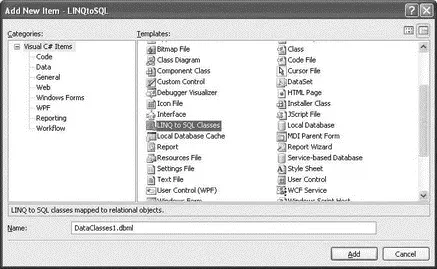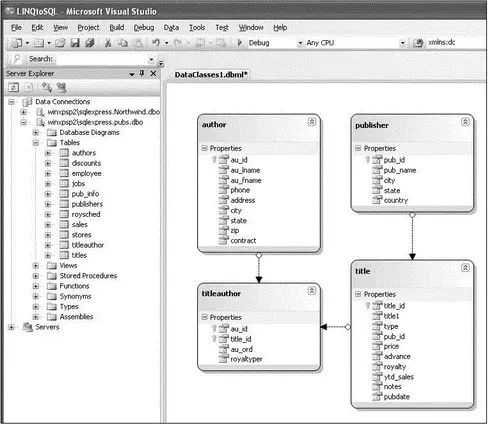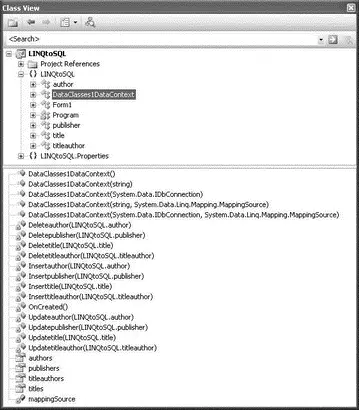When using LINQ to XML to query elements defined with a namespace, you need to specify the namespace explicitly. The following example shows how you can do so using the XNamespaceelement and then using it in your code:
XDocument rss =
XDocument.Load(@"http://www.wrox.com/WileyCDA/feed/RSS_WROX_ALLNEW.xml");
XNamespace dcNamespace = "http://purl.org/dc/elements/1.1/";
var posts =
from item in rss.Descendants("item")
select new {
Title = item.Element("title").Value,
URL = item.Element("link").Value,
Creator = item.Element(dcNamespace + "creator").Value
};
foreach (var post in posts) {
Console.WriteLine("{0}", post.Title);
Console.WriteLine("{0}", post.URL);
Console.WriteLine("{0}", post.Creator);
Console.WriteLine();
}
Figure 14-17 shows the query result.

Figure 14-17
Retrieving Postings in the Last 10 Days
The element in the RSS document contains the date the posting was created. To retrieve all postings published in the last 10 days, you would need to use the Parse()method (from the DateTimeclass) to convert the string into a DateTime type and then deduct it from the current time. Here's how that can be done:
XDocument rss =
XDocument.Load(
@"http://www.wrox.com/WileyCDA/feed/RSS_WROX_ALLNEW.xml");
XNamespace dcNamespace = "http://purl.org/dc/elements/1.1/";
var posts =
from item in rss.Descendants("item")
where (DateTime.Now -
DateTime.Parse(item.Element("pubDate").Value)).Days < 10
select new {
Title = item.Element("title").Value,
URL = item.Element("link").Value,
Creator = item.Element(dcNamespace + "creator").Value,
PubDate = DateTime.Parse(item.Element("pubDate").Value)
};
Console.WriteLine("Today's date: {0}",
DateTime.Now.ToShortDateString());
foreach (var post in posts) {
Console.WriteLine("{0}", post.Title);
Console.WriteLine("{0}", post.URL);
Console.WriteLine("{0}", post.Creator);
Console.WriteLine("{0}", post.PubDate.ToShortDateString());
Console.WriteLine();
}
LINQ to SQL is a component of the .NET Framework (v3.5) that provides a runtime infrastructure for managing relational data as objects.
With LINQ to SQL, a relational database is mapped to an object model. Instead of manipulating the database directly, developers manipulate the object model, which represents the database. After changes are made to it, the object model is submitted to the database for execution.
Visual Studio 2008 includes the new Object Relational Designer (O/R Designer), which provides a user interface for creating LINQ to SQL entity classes and relationships. It enables you to easily model and visualize a database as a LINQ to SQL object model.
Using the Object Relational Designer
To see how LINQ to SQL works, create a new Windows application using Visual Studio 2008.
First, add a new LINQ to SQL Classes item to the project. Use the default name of DataClasses1.dbml(see Figure 14-18).

Figure 14-18
In Server Explorer, open a connection to the database you want to use. For this example, use the pubssample database. Drag and drop the following tables onto the design surface of DataClasses1.dbml:
□ authors
□ publishers
□ titleauthor
□ titles
Figure 14-19 shows the relationships among these four tables.

Figure 14-19
Now save the DataClasses1.dbmlfile, and Visual Studio 2008 will create the relevant classes to represent the tables and relationships that you just modeled. For every LINQ to SQL file you added to your solution, a DataContextclass is generated. You can view this using the Class Viewer (View→Class View; see Figure 14-20). In this case, the name of the DataContextclass is DataClasses1DataContext. The name of this class is based on the name of the .dbml file; if you named the .dbmlfile Pubs, this class is named PubsDataContext.

Figure 14-20
With the database modeled using the LINQ to SQL designer, it's time to write some code to query the database. First, create an instance of the DataClasses1DataContextclass:
DataClasses1DataContext database = new DataClasses1DataContext();
To retrieve all the authors living in CA, use the following code:
var authors = from a in database.authors
where (a.state == "CA")
select new {
Name = a.au_fname + " " + a.au_lname
};
foreach (var a in authors)
Console.WriteLine(a.Name);
To retrieve all the titles in the titlestable and at the same time print out the publisher name of each title, you first retrieve all the titles from the titlestable:
var titles = from t in database.titles
select t;
And then you retrieve each title's associated publisher:
foreach (var t in titles) {
Console.Write("{0} ", t.title1);
var publisher =
from p in database.publishers
where p.pub_id == t.pub_id
select p;
Читать дальше
















